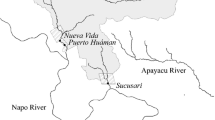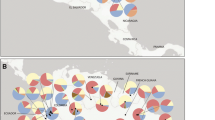Abstract
Distributions of human foraging success across age have implications for many aspects of human evolution. Estimating the distribution of foraging returns is complicated by (1) the zero-inflated nature of hunting returns, as many if not most trips fail, and (2) the substantial variation among hunters, independent of age. We develop a multilevel mixture analysis of human foraging data to address these difficulties. Using a previously published 20-year record of hunts by 147 individual Aché hunters in eastern Paraguay, we estimate returns-by-age functions for both hunting failures and the size of harvests, while also estimating the heterogeneity among hunters. Consistent with previous analyses, we find that most hunters peak around 40 years of age. We can also show, however, that much more of the variation among Aché hunters arises from heterogeneity in failure rates (zero returns), not harvest sizes. We also introduce a new R package, glmer2stan, to assist in defining and fitting similar multilevel mixture models.



Similar content being viewed by others
References
Alvard, M. (1995). Shotguns and sustainable hunting in the neotropics. Oryx, 29, 58–66.
Bliege Bird, R., & Bird, D. W. (2002). Constraints of knowing or constraints of growing? Fishing and collecting by the children of Mer. Human Nature, 13(2), 239–267.
Boyd, R. (1992). The evolution of reciprocity when conditions vary. In A. Harcourt & F. DeWaal (Eds.), Coalitions and alliances in humans and other animals (pp. 473–489). New York: Oxford University Press.
Browne, W. J., Goldstein, H., & Rasbash, J. (2001). Multiple membership multiple classification (MMMC) models. Statistical Modelling, 1, 103–124.
Burnham, K., & Anderson, D. (2002). Model selection and multimodel inference: A practical information-theoretic approach (2nd ed.). New York: Springer.
Cashdan, E. (Ed.). (1990). Risk and uncertainty in tribal and peasant economies. Boulder: Westview Press.
Claeskens, G., & Hjort, N. (2008). Model selection and model averaging. Cambridge: Cambridge University Press.
Efron, B., & Morris, C. (1975). Data analysis using Stein’s estimator and its generalizations. Journal of the American Statistical Association, 70, 311–319.
Fang, Y. (2011). Asymptotic equivalence between cross-validations and Akaike information criteria in mixed-effects models. Journal of Data Science, 9, 15–21.
Gelman, A., & Hill, J. (2007). Data analysis using regression and multilevel/hierarchical models. Cambridge: Cambridge University Press.
Gelman, A., Carlin, J. C., Stern, H. S., & Rubin, D. B. (2004). Bayesian data analysis (2nd ed.). New York: Chapman & Hall/CRC.
Gelman, A., Jakulin, A., Pittau, M. G., & Su, T.-S. (2008). A weakly informative default prior distribution for logistic and other regression models. Annals of Applied Statistics, 2(4), 1360–1383.
Gigerenzer, G. (1991). From tools to theories: a heuristic of discovery in cognitive psychology. Psychological Review, 98(2), 254–267.
Green, E. J., & Porter, R. H. (1984). Noncooperative collusion under imperfect price information. Econometrica, 52(1), 87–100.
Gurven, M. (2006). The evolution of contingent cooperation. Current Anthropology, 47, 185–192.
Gurven, M., Hill, K., Kaplan, H., Hurtado, A., & Lyles, R. (2000). Food transfers among Hiwi foragers of Venezuela: tests of reciprocity. Human Ecology, 28(2), 171–217.
Gurven, M., Kaplan, H., & Gutierrez, M. (2006). How long does it take to become a proficient hunter? Implications for the evolution of delayed growth. Journal of Human Evolution, 51, 454–470.
Hawkes, K., & Bliege Bird, R. (2002). Showing off, handicap signaling, and the evolution of men’s work. Evolutionary Anthropology, 11, 58–67.
Hill, K. (2002). Altruistic cooperation during foraging by the Ache, and the evolved human predisposition to cooperate. Human Nature, 13(1), 105–128.
Hill, K., & Kintigh, K. (2009). Can anthropologists distinguish good and poor hunters? Implications for hunting hypotheses, sharing conventions, and cultural transmission. Current Anthropology, 50(3), 369–377.
Hill, K., McMillan, G., & Fariña, R. F. (2003). Hunting-related changes in game encounter rates from 1994 to 2001 in the Mbaracayu reserve, Paraguay. Conservation Biology, 17(5), 1312–1323.
House, B. R., Silk, J. B., Henrich, J., Barrett, H. C., Scelza, B., Boyette, A., et al. (2013). The ontogeny of prosocial behavior across diverse societies. Proceedings of the National Academy of Sciences (USA). doi:10.1073/pnas.1221217110.
Jones, J., Bird, R., & Bird, D. (2013). To kill a kangaroo: understanding the decision to pursue high-risk/high-gain resources. Proceedings of the Royal Society of London B. doi:10.1098/rspb.2013.1210.
Kaplan, H. S., Hill, K. R., Lancaster, J. B., & Hurtado, A. M. (2000). A theory of human life history evolution: diet, intelligence, and longevity. Evolutionary Anthropology, 9, 156–185.
Kaplan, H. S., Hooper, P. L., & Gurven, M. (2009). The evolutionary and ecological roots of human social organization. Philosophical Transactions of the Royal Society B, 364, 3289–3299.
Kaplan, H. S., Schniter, E., Smith, V. L., & Wilson, B. J. (2012). Risk and the evolution of human exchange. Proceedings of the Royal Society B, 279(1740), 2930–2935.
Koster, J. (2008). Hunting with dogs in Nicaragua: an optimal foraging approach. Current Anthropology, 49, 935–944.
Koster, J. M., & Tankersley, K. B. (2012). Heterogeneity of hunting ability and nutritional status among domestic dogs in lowland Nicaragua. Proceedings of the National Academy of Sciences (USA), 109, E463–E470.
Le, S., & Boyd, R. (2007). Evolutionary dynamics of the continuous iterated prisoner’s dilemma. Journal of Theoretical Biology, 245, 258–267.
Lewandowski, D., Kurowicka, D., & Joe, H. (2009). Generating random correlation matrices based on vines and extended onion method. Journal of Multivariate Analysis, 100, 1989–2001.
Lunn, D., Jackson, C., Best, N., Thomas, A., & Spiegelhalter, D. (2013). The BUGS Book: A practical introduction to Bayesian analysis. Boca Raton: CRC Press.
McCullagh, P., & Nelder, J. A. (1989). Generalized linear models (2nd ed.). New York: Chapman and Hall/CRC Press.
McElreath, R. (2012). glmer2stan: Rstan models defined by glmer formulas, version 0.96. Available online at http://xcelab.net/rm/.
Neal, R. (2011). MCMC using Hamiltonian dynamics. In G. Brooks & M. Jones (Eds.), Handbook of Markov Chain Monte Carlo (pp. 113–162). Boca Raton: Chapman and Hall/CRC Press.
Plummer, M. (2003). JAGS: a program for analysis of Bayesian graphical models using Gibbs sampling. In Proceedings of the 3rd International Workshop on Distributed Statistical Computing (DSC 2003). Available online at http://www.r-project.org/conferences/DSC-2003/Proceedings/.
Plummer, M. (2008). Penalized loss functions for Bayesian model comparison. Biostatistics, 9(3), 523–539.
Rubin, D. B. (1976). Inference and missing data (with discussion). Biometrika, 63, 581–592.
Spiegelhalter, D. J., Best, N. G., Carlin, B. P., & va der Linde, A. (2002). Bayesian measures of model complexity and fit. Journal of the Royal Statistical Society B, 64, 583–639.
Stan Development Team. (2012). Stan: A C++ library for probability and sampling, version 1.0.2. Available online at http://mc-stan.org/.
Stephens, D. W., & Charnov, E. L. (1982). Optimal foraging: some simple stochastic models. Behavioral Ecology and Sociobiology, 10, 251–263.
Stephens, D. W., & Krebs, J. R. (1986). Foraging theory. Princeton: Princeton University Press.
Vaida, F., & Blanchard, S. (2005). Conditional Akaike information for mixed-effects models. Biometrika, 92(2), 351–370.
Walker, R., Hill, K., Kaplan, H., & McMillan, G. (2002). Age-dependency in hunting ability among the Ache of eastern Paraguay. Journal of Human Evolution, 42, 639–657.
Whorf, B. (1941). The relation of habitual thought and behavior to language. In L. Spier (Ed.), Language, culture, and personality, essays in memory of Edward Sapir (pp. 75–93). Menasha: Sapir Memorial Publication Fund.
Winterhalder, B. (1990). Open field, common pot: harvest variability and risk avoidance in agricultural and foraging societies. In E. A. Cashdan (Ed.), Risk and uncertainty in tribal and peasant economies (pp. 67–87). Boulder: Westview Press.
Winterhalder, B., Kennett, D. J., Grote, M. N., & Bartruff, J. (2010). Ideal free settlement of California’s northern Channel Islands. Journal of Anthropological Archaeology, 29, 469–490.
Acknowledgements
Thanks to Mark Grote, Jamie Holland Jones, Bruce Winterhalder, members of the UC Davis Cultural Evolution and Human Behavioral Ecology labs, and two anonymous reviewers for advice and comments. Bob Carpenter and the members of the Stan Development Team helped us improve the efficiency of our Stan code. Keith O’Rourke suggested the analogy between Whorf’s gasoline drums and uninformative priors. Nicholas Blurton-Jones, back in 1997, encouraged RM to find a solution to modeling imbalanced field data, leading him eventually to Bayesian data analysis.
Author information
Authors and Affiliations
Corresponding author
Additional information
The ESM (electronic supplemental materials) are available at http://xcelab.net/humannature/
Rights and permissions
About this article
Cite this article
McElreath, R., Koster, J. Using Multilevel Models to Estimate Variation in Foraging Returns. Hum Nat 25, 100–120 (2014). https://doi.org/10.1007/s12110-014-9193-4
Published:
Issue Date:
DOI: https://doi.org/10.1007/s12110-014-9193-4




